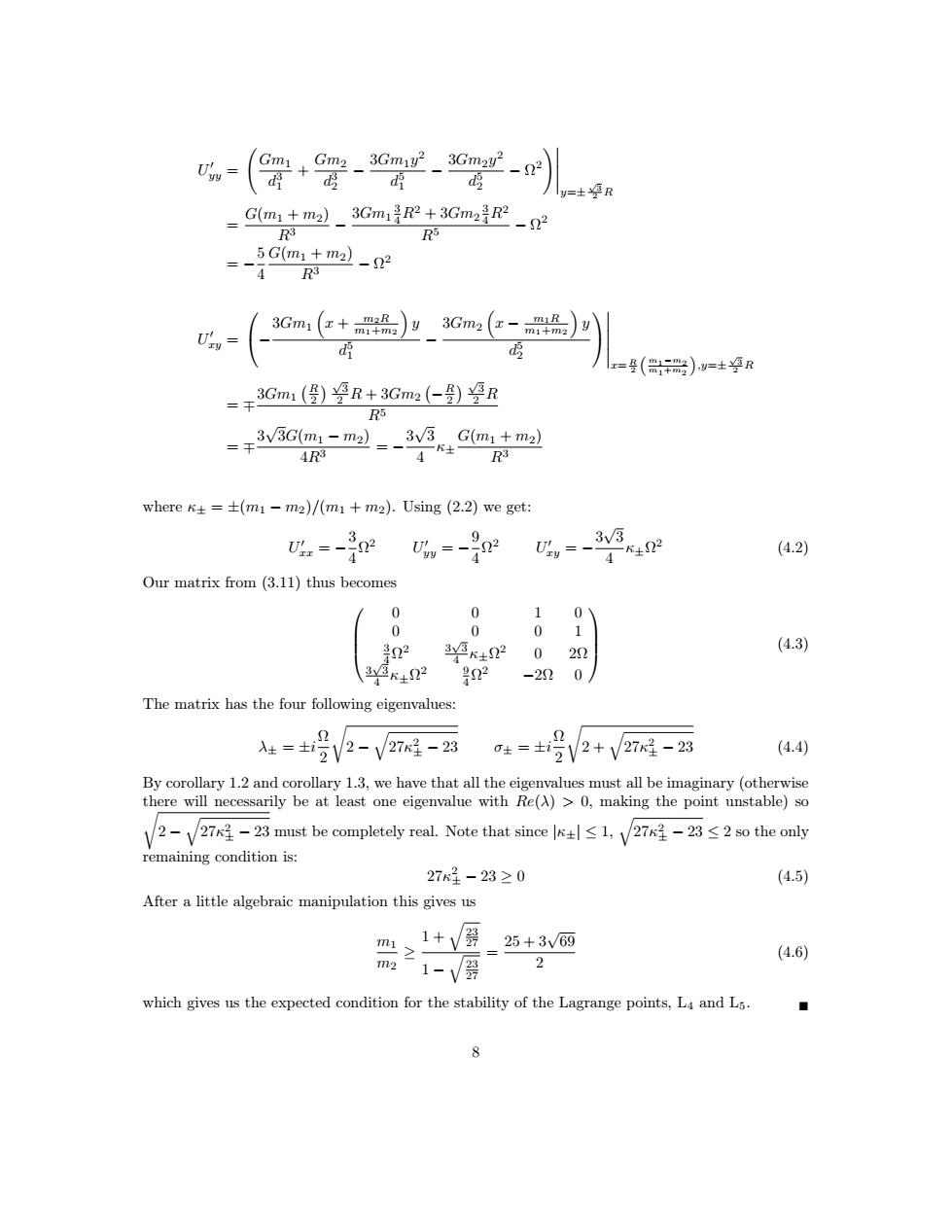正在加载图片...

Uw= Gm2 3Gm1y2 3Gm2y2 -n2 d的 d碣 = G(m1+m2)3Gm1R2+3Gm2R2 R3 R5 -2 5G(m1+m2)-2 心、 4R3 3Gm(e+品)y3Gm2(e-品 m1+m2 d 3Gm1(慢)9R+3Gm2(-号)岁R R5 3V3Gi(m-ma)3G(m ma) 4R3 where=+(m1-m2)/(m1 m2).Using (2.2)we get: %.- Uw=-4 =- v3 4±22 (4.2) Our matrix from (3.11)thus becomes 0 0 1 0 0 0 1 2 3¥24n2 0 22 (4.3) 3K02 0 -22 0 The matrix has the four following eigenvalues: .2 4=±2/2-V27x4-23 2V2+V27星-23 (4.4) By corollary 1.2 and corollary 1.3,we have that all the eigenvalues must all be imaginary (otherwise there will necessarily be at least one eigenvalue with Re(A)>0,making the point unstable)so V2-V27r星-23 must be completely real..Note that since±l≤l,V27k¥-23≤2 so theonly remaining condition is: 271-23≥0 (4.5)) After a little algebraic manipulation this gives us mi 1+√翳 25+3v69 m2 1-V景 2 (4.6) which gives us the expected condition for the stability of the Lagrange points,L4 and L5. ◆U 0 yy = Gm1 d 3 1 + Gm2 d 3 2 − 3Gm1y 2 d 5 1 − 3Gm2y 2 d 5 2 − Ω 2 !
y=± √ 3 2 R = G(m1 + m2) R3 − 3Gm1 3 4R2 + 3Gm2 3 4R2 R5 − Ω 2 = − 5 4 G(m1 + m2) R3 − Ω 2 U 0 xy = − 3Gm1 x + m2R m1+m2 y d 5 1 − 3Gm2 x − m1R m1+m2 y d 5 2
x= R 2 m1−m2 m1+m2 ,y=± √ 3 2 R = ∓ 3Gm1 R 2 √ 3 2 R + 3Gm2 − R 2 √ 3 2 R R5 = ∓ 3 √ 3G(m1 − m2) 4R3 = − 3 √ 3 4 κ± G(m1 + m2) R3 where κ± = ±(m1 − m2)/(m1 + m2). Using (2.2) we get: U 0 xx = − 3 4 Ω 2 U 0 yy = − 9 4 Ω 2 U 0 xy = − 3 √ 3 4 κ±Ω 2 (4.2) Our matrix from (3.11) thus becomes 0 0 1 0 0 0 0 1 3 4Ω 2 3 √ 3 4 κ±Ω 2 0 2Ω 3 √ 3 4 κ±Ω 2 9 4Ω 2 −2Ω 0 (4.3) The matrix has the four following eigenvalues: λ± = ±i Ω 2 r 2 − q 27κ 2 ± − 23 σ± = ±i Ω 2 r 2 + q 27κ 2 ± − 23 (4.4) By corollary 1.2 and corollary 1.3, we have that all the eigenvalues must all be imaginary (otherwise there will necessarily be at least one eigenvalue with r Re(λ) > 0, making the point unstable) so 2 − q 27κ 2 ± − 23 must be completely real. Note that since |κ±| ≤ 1, q 27κ 2 ± − 23 ≤ 2 so the only remaining condition is: 27κ 2 ± − 23 ≥ 0 (4.5) After a little algebraic manipulation this gives us m1 m2 ≥ 1 + q 23 27 1 − q 23 27 = 25 + 3√ 69 2 (4.6) which gives us the expected condition for the stability of the Lagrange points, L4 and L5. . 8